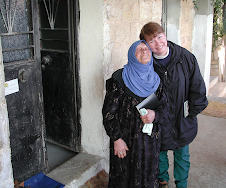
BFFs - Zambesi Affectionately Rests Her Trunk Under Victoria's Ear
I hope you enjoyed the story of the Asian elephants, Coca II and Twinkles, written in 1984. Now I'd like to continue the series with excerpts from an item on Atlanta's African elephants. When I wrote the Asian story, I was barely pregnant with my daughter Holly. When I "interviewed" the three African girls, Holly went along in her stroller and was attended by my niece, Angie, who also helped photograph the elephants. This article appeared in the summer 1990 issue of "Georgia Journal."

Starlet, Zambesi and Victoria Eating Hay
(Now Called Kelly, Dottie, and Tara - Their Original Names)
. . . . . Calves of only 7 and 8 years old, Starlet O'Hara, Victoria and Zambesi are much smaller than mature African elephants, which stand 8 to 13 feet high at the shoulder and measure more than 18 feet long.
The young ladies of Atlanta range from Victoria (6 feet 5 inches tall and 3700 pounds) to Starlet (6 feet 2 inches tall and a mere 3200 pounds).
Being the biggest, Victoria is probably the oldest," estimates Jim Black, Lead Keeper. The 10-year veteran (with three years at Zoo Atlanta) said elephants mature at age 18 to 20, "but adults continue to grow, although very slowly. They grow until their death." Being females, keepers expect these Southern belles to peak at 10 feet tall.

Starlet Catches A Stick With Her Trunk
Asked why all the elephants in Atlanta are cows, Black answered, "Partly because females in the wild live in families and herds. Males don't." In captivity, mature bulls can be "difficult and dangerous to work with and have killed people," according to Black.
Although Zoo Atlanta's three brown-eyed beauties are female and youngsters, Black and other keepers exercise great caution with them.

Starlet Holds Her Foot Up for Black To Inspect It
"Elephants are curious, destructive, incredibly strong. You have to watch them, Black said. "They see something; they think, 'Will it break? Can I eat it?'" In a zoo where Black formerly worked, an adult female elephant ate three wooden pallets. In fact, a curious elephant's theme song could be "Let's Get Physical."
Elephants are "physical" with each other, he said. Even very young females. "They thump each other with their trunks -- hard!" At that moment, Black cocked his head, listening. Going to a steel door leading into the barn, he smiled as he looked inside.
Starlet and Zambesi shuffled around quietly, making a slight snuffling sound. They pushed each other with their trunks, butted with their heads, whirled this way and that swiftly and easily. The "sparring" is play, but also helps determine the "pecking order" of the group. Victoria, "cock of the walk" because of her larger size, peacefully ate hay in the corner. As soon as the combatants heard Black's voice at the door, they hurried over to investigate. Starlet's trunk tip slithered through the slot in the door, trying to grab the visitor's hand. "Move back, Goof," Black said affectionately. The elephants immediately backed away from the door. Victoria resumed her dinner. Starlet and Zambesi began Round 10.

Starlet And Zambesi Sparring
Even though Starlet and Zambesi don't escalate from a sparring match to an angry fight, they do occasionally get into minor scrapes. "I have seen one adult knock another down. That's why we can't relate to them as a person, but as a dominant elephant."
To achieve dominance when he is so small compared to his charges, a keeper uses an ankus (Indian name) or elephant hook. This is a tool with a wooden handle about two feet long with a metal point and hook on one end. The point is blunt, the hook a little sharper. "It is like a leash for a dog or a bridle for a horse," Black said. It helps the keeper communicate with an animal of tremendous size and strength.

Jim Black Using Elephant Hook Or Ankus
"I can use it like an elephant uses its tusks, to prod. An elephant would pay no attention to my hand pushing or pulling against it. The tip of the elephant stick concentrates pressure. Used properly, it doesn't hurt. I'd like to emphasize that positive reinforcement (such as praise and treats), not fear and pain, are important in training. This is especially true in African elephants."
Asked why the zoo picked African elephants instead of Asians like the others the zoo had in the past, Black replied, "This section of the zoo has an African theme, so we have African elephants." In June, 1989, the new elephant habitat opened, which is "like a chunk of East Africa," modeled after Tsavo National Park in Kenya.

Starlet Shows Her Agility
After a rain, the Georgia red clay can be kneaded into a paste for a comfortable wallow. Elephants love their mud baths, but they adore swimming. The new habitat features a 65,000-gallon pond, which the elephants use constantly in warm weather. For now, the keepers bathe them every day and scrub them with Ivory Liquid every other day. The baths of water, sand and mud protect elephants' skin from sun and insects. Their skin, though an inch thick, is tender. This is something they have in common with their Asian cousins.

Starlet Performing At Zoo Atlanta
Black said Asian and African elephants could be kept in the same habitat; socially they are similar. But there are differences: The smaller Asians measure eight to 10 feet at the shoulder and weigh about five and one-half tons. Also, the larger ears of the Africans resemble the continent of Africa in shape. The Africans have two finger-like appendages at the tip of their trunks; the Asians have one. In the Africans, both males and females have tusks; only male Asians have them.
"Intellectually, Asians are quicker to manipulate objects and get with things faster," Black said. "They are equally trainable, but Africans are more high-strung and temperamental. They won't take as much pressure. You have to be more patient. Caring for elephants is a lot like raising kids.

Gary Roesinger Making Snack of Apples and "Vitamin Sandwiches" for Three Growing Girls

Roesinger Feeds A "Vitamin Sandwich" To A Willing Starlet While Black Watches and Victoria Waits Her Turn
"They run through the barn. They trumpet and throw their balls and tire and other toys when they are tired of being cooped up inside," Ms. Forrest said.
Note Starlet's "Africa-Shaped" Ears
Black added, "They always seem to get into mud before a show and when they flip 15- to 20-pound ears covered in mud, it really splatters in your face. They also seem to delight in tracking mud on the floor just as you finish mopping it." Still, some of their antics amuse rather than exasperate.
"Starlet acts goofy," Black said. "Sometimes when we feed them, she puts a large amount of hay on her head and just walks around looking ridiculous. And they're wild in mud and water. They will sit in the water on their haunches, like a dog, and splash around themselves in a complete circle with their trunks." They also like mud wrestling. "One will be rolling around in the mud and another will straddle it. They scream and thrash around, then the third one joins in and sits on the first one's head." Their play remains relatively gentle, however, for the three seem to truly care for each other.
Like first graders holding hands, Victoria and Zambesi stand close, with Zambesi's trunk nestled under Victoria's huge ear. When separated by a building which blocks the infrasound rumble (too low for humans to hear) with which they communicate 80 per-cent of the time, the "best friends" become frantic, Ms. Forrest said. They must be scolded and appeased with treats until they are in touch once more. Their dependence upon their keepers also manifests itself in touching ways.

Starlet Sitting Tall On A Drum
Although discipline might be viewed by the pachydermal eye as a poke with the prod, the elephants allow the pricks of blood tests and "shots" as long as comforting words, like "good girl" and "it's okay," are offered -- along with an apple afterwards. When training becomes confusing, an errant lass might "do something they know, something else to try to please us," Ms. Forrest said. This desire to please is apparent in the skills exhibited during the elephant shows staged thrice daily.

Starlet Stands On Two Feet
Starlet performed almost flawlessly on the unseasonably warm January afternoon of this interview. She bowed, stood on a drum on two feet, lay down, lifted her feet for inspection, held up her trunk, nodded, walked in a circle, and caught three sticks in her trunk as Black tossed them. Then she unfurled a sign reading "The End" before bowing to appreciative applause. Later, when I entered their barn for photographs, I appreciated even more Black's control over the three huge, rambunctious youngsters.

Coca II 1984

Twinkles With Head Keeper Ed Myers 1984
The three Africans were well behaved but, like toddlers, unpredictable. Compared with Twinkles, they were more active, more pushy about trying to investigate me. Twinkles stood quietly, just eying me and slowly edging closer. The terrific trio prowled around, surrounding me and closing in quickly. Standing there inhaling the fresh smell of hay, I felt like a bug with three curious lads crowding around with magnifying glasses in hand. However, they obeyed Black readily, wheeling away lightly on their tree-trunk legs when told to "back off." Meanwhile, I was curious about them, too.

Starlet Laying Down On The Job
Starlet Entertains Afternoon Crowds
Gary Roesinger, elephant keeper, told of Starlet's dismay and confusion after Coca's death. "She kept looking around, moving rapidly from place to place." The keeper shook his dark head sadly as he made sandwiches of bread pressed tightly around vitamin supplements. Black said, "They are grief-stricken when another elephant dies. To see a mother with a dead baby is heart-rending. She will stand by it for hours, trying to pick it up." He guessed Starlet, Victoria and Zambesi are the "left overs" of culls (the killing of whole herds of elephants when their numbers get too great).
These three were fortunate to have survived. While they must have suffered grief caused by the death of their families, together they have formed a new family. Intelligent, sensitive, social, flexible, the world's largest land animals continue to amaze and delight us.


Starlet Unfurls Sign Reading "The End"




























No comments:
Post a Comment